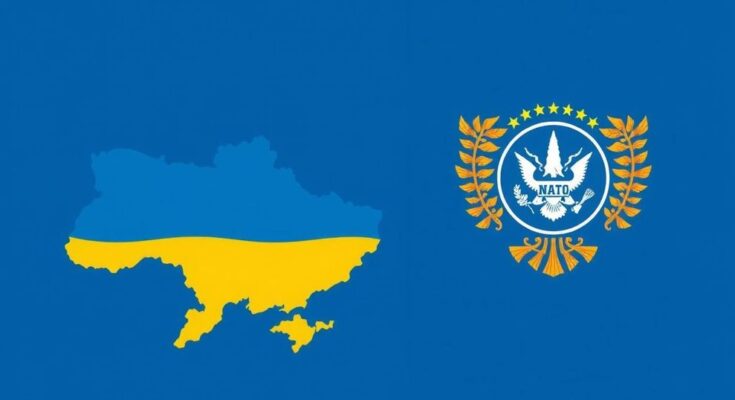The impending U.S. presidential election raises concerns among NATO defense chiefs about the future of support for Ukraine, particularly if Donald Trump is re-elected. As NATO prepares for potential decreased U.S. involvement, countries are ramping up their arms production and consolidating training and military assistance for Ukraine. The strategic overhaul underscores the alliance’s commitment to maintaining support amid fears of increasing Russian military capacity, aided by nations such as North Korea and Iran.
The approaching United States presidential election casts a shadow over the recent NATO defense chiefs’ meeting, where concerns regarding future American support for Ukraine emerged. As speculation grows that aid may be reduced if Donald Trump is re-elected, NATO allies are increasingly anxious, especially in light of escalating military support from adversarial nations like Iran, North Korea, and China to Russia. Secretary of Defense Lloyd Austin addressed these concerns during closed-door discussions, affirming that he could not foresee the election’s outcome, but emphasized that bipartisan support for Ukraine still exists within Congress. NATO officials have begun preparing for a potential shift in U.S. involvement, with one senior official stating, “We cannot expect that the US will continue to take on an outsized burden” regarding Ukraine support. There is a clear call for Europe to increase its own contributions. The prospect of a Trump administration raises uncertainties about U.S. policy towards Ukraine, as Trump has previously indicated a lack of support for Ukraine’s victory and criticized Ukrainian leadership. The current battlefield dynamics are troubling, with Russian forces reportedly achieving tactical gains while outnumbering Ukrainian firepower three to one. NATO officials, expressing concern over these developments, have noted that U.S. policy restricts Ukraine’s use of long-range missiles against Russian targets, which many within NATO find limiting. Secretary Austin, however, proposed that Ukraine might effectively utilize its own cost-effective drones for targeting purposes, suggesting this method could prove more efficient than expensive guided missiles. In anticipation of a potential decrease in American support, NATO is moving toward greater control over military assistance and training for Ukrainian forces. This reorganization aims to ensure that European allies are not left vulnerable if U.S. aid lessens under a possible Trump administration. Concurrently, European countries are enhancing their arms production capacities to bolster Ukraine’s defensive needs and their own security in light of Russian aggression. Furthermore, diplomatic efforts among EU and G7 nations to secure sustained financial support for Ukraine are in a precarious position, particularly as Hungary has stalled critical decisions that could unlock a substantial loan for Ukraine from frozen Russian assets until after the U.S. elections. In contrast, the Biden administration works diligently to provide Ukraine with necessary resources amidst these uncertainties, focusing on bolstering Ukraine’s defense industry for self-sufficiency in munitions production. The rapidly deteriorating situation on the battlefield is exacerbated by Russia’s robust munitions production capabilities, which currently outstrip NATO’s output. NATO officials have warned that Russia is not only producing high volumes of weaponry but is also receiving considerable support from nations such as North Korea, which has supplied significant quantities of ammunition and personnel, as well as ballistic missiles from Iran and vital assistance from China. Ultimately, Secretary Austin assures allies of the U.S. commitment to increasing domestic arms production to sustain aid to Ukraine, while NATO Secretary General Mark Rutte expresses confidence in the alliance’s unity and underscores the necessity of supporting Ukraine as a strategic investment in collective security.
As the NATO alliance grapples with imminent changes in U.S. political leadership, the implications for aid to Ukraine are significant. The United States has been a pivotal supporter of Ukraine since the start of the Russian invasion, with the potential for a shift in this support prompting discussions among NATO members. The dynamics of military aid are now interwoven with the outcomes of the upcoming U.S. presidential election, particularly with Donald Trump’s ambiguous stance on Ukraine. This provides context for NATO’s strategic adjustments center around European countries increasing their contributions and capabilities in light of potential U.S. withdrawal of support.
The convergence of the U.S. presidential election’s impending outcome and the ongoing conflict in Ukraine presents a complex challenge for NATO. With the possibility of reduced U.S. support if Donald Trump wins, there is a concerted effort among NATO members, particularly European nations, to assume greater financial and military responsibility for Ukraine. The situation on the ground remains dire, necessitating urgent and decisive action to ensure a unified NATO response, reinforcing that support for Ukraine remains a critical component of collective security efforts.
Original Source: www.cnn.com




